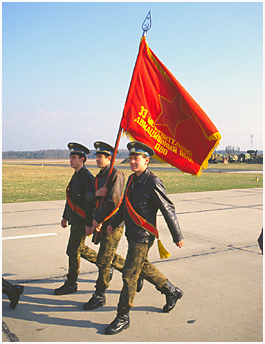 La dénomination complète d’un régiment d'aviation comprenait le cas échéant, outre son numéro et la description de sa fonction
(XXème régiment d'aviation de XXXX), des attributs supplémentaires. Ainsi les décorations remises à celui-ci étaient citées
(par exemple, ordre de Koutouzov de seconde classe). De même, les noms de lieux où l’unité s’était particulièrement distinguée
au combat étaient également cités. Dans ce dernier cas, cette attribution était décernée par les autorités supérieures et avait
valeur en quelque sorte de décoration. L’exemple le plus connu est celui du régiment français « Normandie », dont le nom de
baptême s’était vu adjoindre celui de « Niemen », sur ordre de Staline lui-même le 21 juillet 1944. Les unités de la
garde reprenaient bien entendu ce titre. D'autre part, les unités décorées de l'ordre du Drapeau rouge (orden Krasnogo
znameni) méritent une mention particulière, car cette distinction apparaissait dans leur nom
avec seulement la mention "drapeau rouge" (Krasnoznamennaya ou encore Krasnoznamenniy selon la déclinaison) plutôt qu'avec
l'énumération complète de la décoration. Précisons qu'il existait un ordre militaire (orden boyevogo Krasnogo znameni) obtenu pour
faits d'armes et un ordre civil (orden troudovoy Krasnogo znameni) obtenu "pour avoir bien travaillé." Cette
façon d’énoncer un régiment d'aviation était également valable pour les unités plus importantes telles que les divisions, les corps
ou encore les armées.
A titre d’exemple concret, citons le 31.GvIAP de Falkenberg dont la désignation officielle était : 31ème régiment d'aviation de chasse
de la garde Nikopolskiy, décoré des ordres de Souvorov et du Drapeau rouge, soit en Russe : 31 gvardeiskiy istrebitelniy
aviatsionniy Nikopolskiy Krasnoznamenniy ordena Souvorova polk.
La dénomination complète d’un régiment d'aviation comprenait le cas échéant, outre son numéro et la description de sa fonction
(XXème régiment d'aviation de XXXX), des attributs supplémentaires. Ainsi les décorations remises à celui-ci étaient citées
(par exemple, ordre de Koutouzov de seconde classe). De même, les noms de lieux où l’unité s’était particulièrement distinguée
au combat étaient également cités. Dans ce dernier cas, cette attribution était décernée par les autorités supérieures et avait
valeur en quelque sorte de décoration. L’exemple le plus connu est celui du régiment français « Normandie », dont le nom de
baptême s’était vu adjoindre celui de « Niemen », sur ordre de Staline lui-même le 21 juillet 1944. Les unités de la
garde reprenaient bien entendu ce titre. D'autre part, les unités décorées de l'ordre du Drapeau rouge (orden Krasnogo
znameni) méritent une mention particulière, car cette distinction apparaissait dans leur nom
avec seulement la mention "drapeau rouge" (Krasnoznamennaya ou encore Krasnoznamenniy selon la déclinaison) plutôt qu'avec
l'énumération complète de la décoration. Précisons qu'il existait un ordre militaire (orden boyevogo Krasnogo znameni) obtenu pour
faits d'armes et un ordre civil (orden troudovoy Krasnogo znameni) obtenu "pour avoir bien travaillé." Cette
façon d’énoncer un régiment d'aviation était également valable pour les unités plus importantes telles que les divisions, les corps
ou encore les armées.
A titre d’exemple concret, citons le 31.GvIAP de Falkenberg dont la désignation officielle était : 31ème régiment d'aviation de chasse
de la garde Nikopolskiy, décoré des ordres de Souvorov et du Drapeau rouge, soit en Russe : 31 gvardeiskiy istrebitelniy
aviatsionniy Nikopolskiy Krasnoznamenniy ordena Souvorova polk.
Toutes ces informations se retrouvaient sur les drapeaux des unités, ces derniers constituant une source d’information à la fois fiable et complète, lorsque la très rare opportunité de les consulter se présentait.
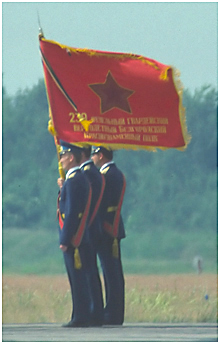 Cet agrandissement nous montre le drapeau du 239.OGvVP d'Oranienburg. Il y est écrit : "239 otdelniy
gvardeiskiy vertoletniy Belgorodskiy Krasnoznamenniy polk", soit 239è régiment autonome d'hélicoptéres de la garde Belgorodski,
décoré de l'ordre du Drapeau rouge. © H.Mambour
Cet agrandissement nous montre le drapeau du 239.OGvVP d'Oranienburg. Il y est écrit : "239 otdelniy
gvardeiskiy vertoletniy Belgorodskiy Krasnoznamenniy polk", soit 239è régiment autonome d'hélicoptéres de la garde Belgorodski,
décoré de l'ordre du Drapeau rouge. © H.Mambour
That enlargement shows the 239.OGvVP flag. One can read on the original slide: '239 otdelniy
gvardeiskiy vertoletniy Belgorodskiy Krasnoznamenniy polk', which means 239th separate guards helicopter regiment Belgorodski,
awarded with the combat Red Banner order. © H.Mambour
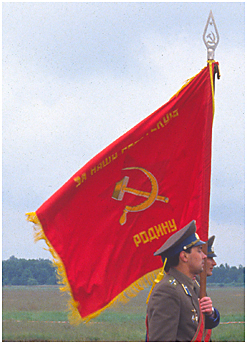 L'autre face du drapeau du 239.OGvVP nous dévoile le côté commun à tous les drapeaux régimentaires. On y voit le marteau
et la faucille entourés de la mention "Za Nachou Sovietskouyou Rodinou" (Pour notre Patrie soviétique). © H.Mambour
L'autre face du drapeau du 239.OGvVP nous dévoile le côté commun à tous les drapeaux régimentaires. On y voit le marteau
et la faucille entourés de la mention "Za Nachou Sovietskouyou Rodinou" (Pour notre Patrie soviétique). © H.Mambour
The other side of the 239.OGvVP flag shows us the side common to all regimental flags. The hammer and sickle
in the centre is surrounded by the motto 'Za Nashu Sovetskuyu Rodinu' (For our Soviet Motherland). © H.Mambour
Une face du drapeau était ornée d’une grande
étoile rouge stylisée avec la dénomination complète de l’unité brodée en dessous. L’autre côté était quant à lui décoré du
marteau et de la faucille en son centre et de la mention « Pour notre Patrie soviétique » brodé pour partie au-dessus et pour
partie en dessous.
Cette dernière remplaçait la formule « Mort aux envahisseurs allemands » qui ornait les drapeaux durant la Grande guerre patriotique.
Dès le 11 juin 1945, un ordre de l'administration politique de l'Armée rouge demandait le retrait de cette mention des revues et autres
journaux en circulation dans l'armée et son remplacement par « Pour notre Patrie soviétique. » C'est ainsi que les drapeaux datant de la
seconde guerre mondiale ont rejoint à un moment donné les musées ou les salles des traditions des régiments, lorsqu'ils furent remplacés
par de nouvelles bannières mises au goût du jour.
Les drapeaux des unités de la Garde (leur design variait selon le type d’unité et l’arme) se présentaient sous un aspect un peu différente pendant la Grande guerre patriotique, lorsque ces unités furent créées. Ces bannières étaient ornées d’un côté du portrait de Lénine au centre avec la mention en caractères cyrilliques « CCCP » en dessous et la citation « Pour notre Patrie soviétique » au-dessus, tandis que l’autre face affichait d’une part la dénomination complète de l’unité en bas et au-dessus, une petite étoile rouge avec en son centre le marteau et la faucille, et d’autre part la mention « Mort aux envahisseurs allemands ». Les nouveaux drapeaux d'après-guerre seront mis aux standards des autres unités avec simplement la mention « de la garde » ajouté dans le libellé décrivant l'unité. Pour davantage d'informations concernant les unités de la Garde, vous pouvez consulter la seconde partie du chapitre « La chasse » où le sujet est traité.
Dénomination complète des unités et noms de code ici.
Les drapeaux soviétiques : Flagspot.net
Traditions
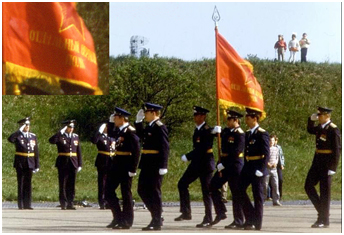 The complete designation of an aviation regiment was composed of its number, its speciality (XX fighter aviation regiment) and additional
attributes. The latter comprised possible awards (for exemple, Kutuzov order) or the name(s) of places where the
unit distinguished itself during combat operations in WWII. In that case, the name was bestowed by higher authorities and was
somewhat equivalent to an award. A well-known exemple is the French regiment "Normandie" (Normandie is a French baptism
name unrelated to its activities in USSR) that received the name "Niemen" on 21 July 1944 by order of Stalin himself.
Guards units had, of course, that title in their unit designation. Units awarded with the Combat Red Banner Order
(orden Krasnogo boyevogo znameni) had only the mention "Red Banner" (Krasnoznamennaya or Krasnoznamennyy)
in their name. It also should be mentioned that, in addition to the Combat Red Banner Order, a civilian
"Labour" Red Banner Order existed (orden trudovoy Krasnogo znameni).
The system was the same for larger units like divisions, corps and armies. As a concrete exemple,
let's mention the 31.GvIAP from Falkenberg. Its official designation was: 31st Guards Fighter Aviation Nikopol'skiy
Combat Red Banner Order of Suvorov Regiment, or in translitered Russian:
31 gvardeiskiy istrebitelnyy aviatsionnyy Nikopol'skiy Krasnoznamennyy ordena Suvorova polk.
All this information was embroidered on the regimental flags, but the opportunity to examine them was rare.
The complete designation of an aviation regiment was composed of its number, its speciality (XX fighter aviation regiment) and additional
attributes. The latter comprised possible awards (for exemple, Kutuzov order) or the name(s) of places where the
unit distinguished itself during combat operations in WWII. In that case, the name was bestowed by higher authorities and was
somewhat equivalent to an award. A well-known exemple is the French regiment "Normandie" (Normandie is a French baptism
name unrelated to its activities in USSR) that received the name "Niemen" on 21 July 1944 by order of Stalin himself.
Guards units had, of course, that title in their unit designation. Units awarded with the Combat Red Banner Order
(orden Krasnogo boyevogo znameni) had only the mention "Red Banner" (Krasnoznamennaya or Krasnoznamennyy)
in their name. It also should be mentioned that, in addition to the Combat Red Banner Order, a civilian
"Labour" Red Banner Order existed (orden trudovoy Krasnogo znameni).
The system was the same for larger units like divisions, corps and armies. As a concrete exemple,
let's mention the 31.GvIAP from Falkenberg. Its official designation was: 31st Guards Fighter Aviation Nikopol'skiy
Combat Red Banner Order of Suvorov Regiment, or in translitered Russian:
31 gvardeiskiy istrebitelnyy aviatsionnyy Nikopol'skiy Krasnoznamennyy ordena Suvorova polk.
All this information was embroidered on the regimental flags, but the opportunity to examine them was rare.
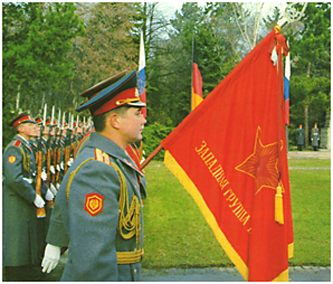 Le drapeau du Groupe des Forces Ouest. Il y est inscrit : Zapadnaya Grouppa Voïsk. © D.R.
Le drapeau du Groupe des Forces Ouest. Il y est inscrit : Zapadnaya Grouppa Voïsk. © D.R.
The Western Group of Forces flag. Zapadnaya Gruppa Voïsk is embroidered on the red star side.
© D.R.
One face of the flag was decorated with a stylized red star with the complete name of the unit embroidered below. On the other hand,
the reverse was adorned with the hammer and the sickle in the center and the motto "For our Soviet Motherland"
divided above and below.
The latter replaced the motto "Death to the German invaders" that adorned the flags during the Great Patriotic War. A command the Red Army Political Administration issued 11 June 1945 decreed the withdrawal of that mention from journals and newspapers circulating in the armed forces and its replacement with "For our Soviet Motherland." This is how the flags of World War II vintage at one point joined regional or unit museums when they were replaced by new banners to be up with the current tastes.
The Guards banners were somewhat different - their design varied depending on the unit type and the branch of the armed forces - when they were created during WWII. They were decorated with Lenin's head in the center of one face with Cyrillic letters "CCCP" below and the mention "For our Soviet Motherland" above, whereas the reverse was adorned with the complete unit designation below and a small red star covered with the hammer and sickle and the motto "Death to German invaders" above. The new post-war flags were set to the standards of the other units with simply the word "Guards" added to the wording describing the unit. More information about Guards units can be found in the chapter entitled "The fighters".
Complete unit designations and code names here.
Soviet flags : Flagspot.net
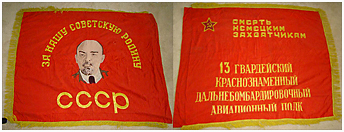
| 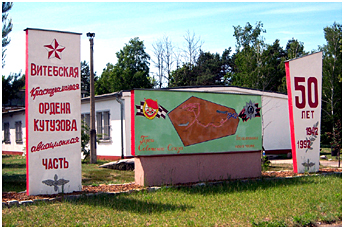 |
 |
Plan du site - Sitemap |  |
